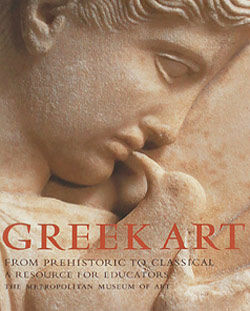Terracotta statuette of a standing woman
Although the Greeks had been making terracotta statuettes since the eighth century B.C., it was not until the late fourth century that they began to produce the clay figurines that are still prized for their naturalness, variety, and charm. These statuettes were first made in Athens and were soon being fabricated throughout the Mediterranean world, but they take their name from Tanagra, an ancient city in Boeotia, the region north of Attica, where great numbers were illicitly removed from tombs in the early 1870s. Whereas almost all earlier terracotta figurines represented deities, the majority of Tanagras are fashionable women or girls elegantly wrapped in thin "himatia" (cloaks), often wearing large sun hats and holding wreaths or fans. While most stand gracefully, some are seated or playing games. A number of boys are represented and Aphrodite and Eros appear as well.
Many of these figurines have been discovered in private dwellings. Like other small-scale sculpture found in houses, they probably had a religious purpose and were placed in domestic shrines. They were also dedicated in sanctuaries and put in tombs. Up to a dozen statuettes were found in some graves at Tanagra. Since fashionable ladies did not usually spend much time outdoors, religious festivals and funeral processions offered the best opportunities for displaying their finery. It is therefore possible that for all their secular appearance, the Tanagras indirectly conveyed to the ancient viewer a reminder of serious ceremonies.
Their relaxed curvaceous poses, sweet faces, and tightly wrapped drapery that forms a complex pattern of fine folds all derive from large-scale sculpture, such as the statues of Praxiteles, the famous Athenian sculptor who was active in the mid-fourth century B.C. The intimate, secular spirit of the Tanagras also reflects contemporary comedies by Athenian playwrights such as Menander, which placed new emphasis on the foibles of everyday life. The figurines still convey a sense of immediacy and liveliness that marks them as true works of art.
Due to rights restrictions, this image cannot be enlarged, viewed at full screen, or downloaded.




